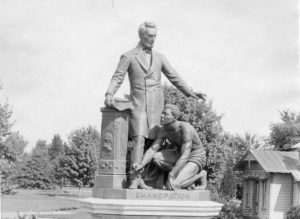
Albert Pike. Andrew Jackson. Emancipation Memorial in Lincoln Park. Woodrow Wilson High School. These local memorial statues and institutions have drawn the ire of Black Lives Matter protesters and others who object to their messages and their iconography. The public is focusing, many for the first time, on these once nearly invisible features of our city. The current protests are fueling a new consciousness of what it means to erect a memorial and how the original intentions of the creators have been lost to time or no longer speak to the majority of the American people.
To understand how these monuments happened—especially the ones found around the South and in the Capitol’s Statuary Hall honoring the Confederate States of America and the Civil War—we offer these resources. And to quote historian Kirk Savage, “If there is one lesson to be learned from studying how monuments get chosen and built, it is that they most certainly do not represent history in any straightforward or responsible way. They represent the agendas, obsessions, prejudices, whims, and, occasionally, the high ideals and aspirations of those people in society who happened to have the power to erect them in public.”
Recommended Reading
“The complicated racial history of the high school D.C. is renaming,” by Stefan Fatsis, Washington Post, Dec. 28, 2020.
Why and how the District of Columbia is renaming Woodrow Wilson High School.
“Confederate Island upon the Union’s ‘Most Hallowed Ground’: The Battle to Interpret Arlington House, 1921–1937,” by Michael B. Chornesky, Washington History 27-1 (spring 2015) Purchase Online
Arlington House, visible across the Potomac from the Lincoln Memorial, was built as the home of George Washington’s adopted grandson, George Washington Park Custis. Custis’s daughter Mary then married a rising U.S. Army officer, Robert E. Lee. But once the Civil War began, Lee defected to the Confederacy as the commander of its forces. Arlington House was commandeered by the Union forces to become a defense of Washington, and, eventually, a cemetery (today’s Arlington National Cemetery.) Then, after the war, Arlington house became a battleground between federal officials and southern white supremacists to prevent Arlington House from becoming a shrine to Confederate commander Robert E. Lee. Chornesky’s essay details how proponents of the “Lost Cause” narrative of the Civil War—that the noble, slave-holding South was destroyed by a tyrannical Republican government—kept their myth alive through lobbying and public relations that led to ubiquitous statues, memorials, and educational materials.
Standing Soldiers, Kneeling Slaves: Race, War, and Monument in Nineteenth-Century America, by Kirk Savage (Princeton: Princeton University Press,2018), chapter 4.
“Molding Emancipation: John Quincy Adams Ward’s ‘The Freedman’ and the Meaning of the Civil War,” on JSTOR by Kirk Savage, Art Institute of Chicago Museum Studies, Terrain of Freedom: American Art and the Civil War 27-1 (2001).
Art Historian Kirk Savage produced these two works that detail how the Emancipation Memorial in Lincoln Park came to be, clarifying the roles of the formerly enslaved who funded it, and the white committee that chose the design.
“What Frederick Douglass Had to Say About Monuments,” by Jonathan W. White and Scott Sandage, Smithsonianmag.com, June 30, 2020.
Understanding Frederick Douglass’s criticism of the Emancipation Memorial with a discussion of how to contend with problematic memorials.
“‘Union’ tells the origin story of the United States through 19th-century voices,” by David W. Blight, Washington Post, June 24, 2020
“Master narratives” are versions of our history that are widely accepted, and often widely contested. This review of “Union: The Struggle to Forge the Story of United States Nationhood,” by Colin Woodard, looks at how the author, “succeeds in demonstrating the high stakes of master narratives, versions of the past that people choose as identities and stories in which they wish to live.”
“A homeless Confederate? Albert Pike’s complicated legacy leaves statue in limbo” by Jenna Portnoy, Washington Post, November 4, 2017
A summary of the Albert Pike statue story written in 2017 amid calls for its removal, three years before Black Lives Matter protesters tore it down.
Build Your Library
And check out these local bookstores: Mahogany Books, Loyalty Bookstores, Sankofa, Wisdom Book Center, Harambee Books, Second Story Books, Politics and Prose